Supply Chain Assessment 2022
VerifiedAdded on 2022/10/09
|8
|2259
|36
AI Summary
Contribute Materials
Your contribution can guide someone’s learning journey. Share your
documents today.

Assessment 2 Supply Chain 1
Assessment 2 Supply Chain
Student Name
Institution
Assessment 2 Supply Chain
Student Name
Institution
Secure Best Marks with AI Grader
Need help grading? Try our AI Grader for instant feedback on your assignments.
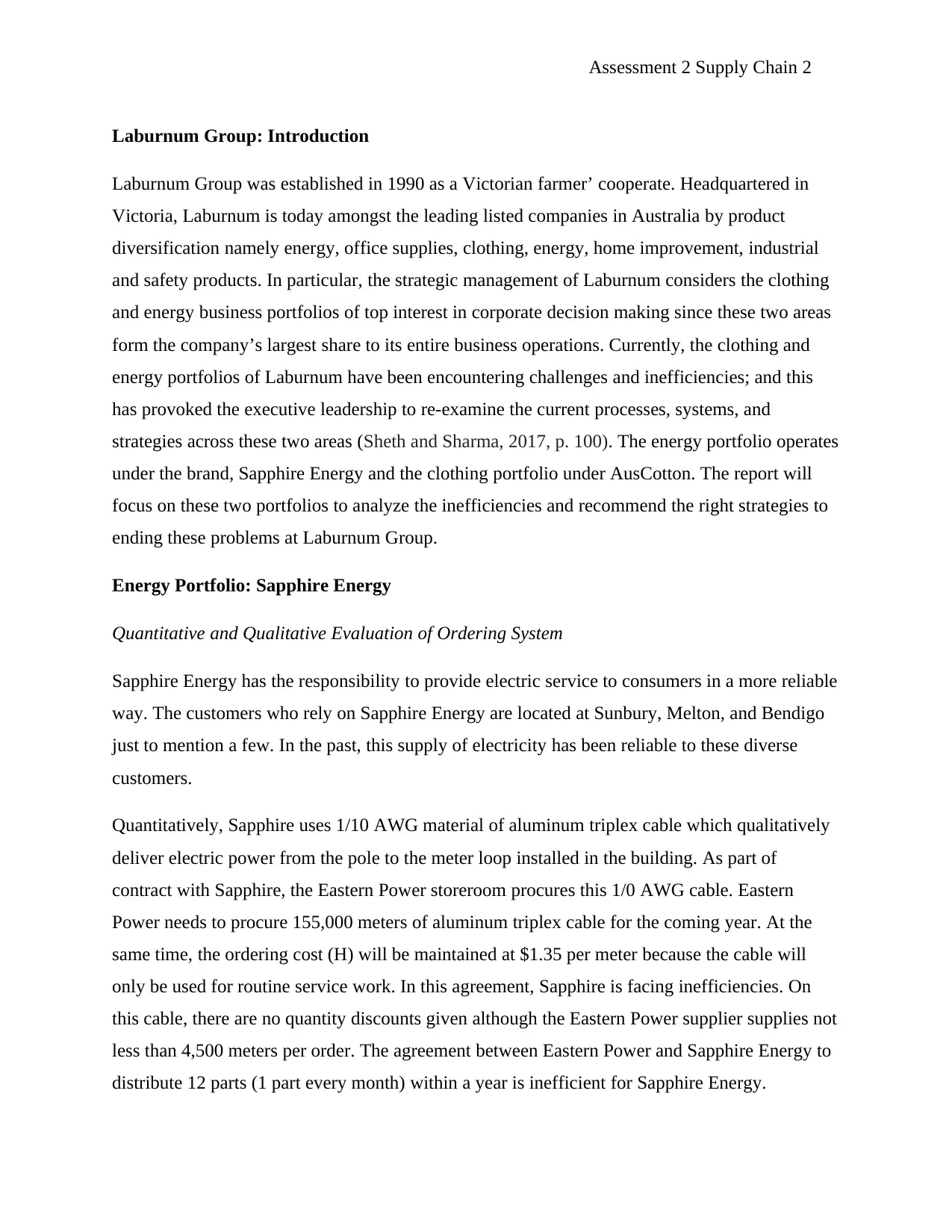
Assessment 2 Supply Chain 2
Laburnum Group: Introduction
Laburnum Group was established in 1990 as a Victorian farmer’ cooperate. Headquartered in
Victoria, Laburnum is today amongst the leading listed companies in Australia by product
diversification namely energy, office supplies, clothing, energy, home improvement, industrial
and safety products. In particular, the strategic management of Laburnum considers the clothing
and energy business portfolios of top interest in corporate decision making since these two areas
form the company’s largest share to its entire business operations. Currently, the clothing and
energy portfolios of Laburnum have been encountering challenges and inefficiencies; and this
has provoked the executive leadership to re-examine the current processes, systems, and
strategies across these two areas (Sheth and Sharma, 2017, p. 100). The energy portfolio operates
under the brand, Sapphire Energy and the clothing portfolio under AusCotton. The report will
focus on these two portfolios to analyze the inefficiencies and recommend the right strategies to
ending these problems at Laburnum Group.
Energy Portfolio: Sapphire Energy
Quantitative and Qualitative Evaluation of Ordering System
Sapphire Energy has the responsibility to provide electric service to consumers in a more reliable
way. The customers who rely on Sapphire Energy are located at Sunbury, Melton, and Bendigo
just to mention a few. In the past, this supply of electricity has been reliable to these diverse
customers.
Quantitatively, Sapphire uses 1/10 AWG material of aluminum triplex cable which qualitatively
deliver electric power from the pole to the meter loop installed in the building. As part of
contract with Sapphire, the Eastern Power storeroom procures this 1/0 AWG cable. Eastern
Power needs to procure 155,000 meters of aluminum triplex cable for the coming year. At the
same time, the ordering cost (H) will be maintained at $1.35 per meter because the cable will
only be used for routine service work. In this agreement, Sapphire is facing inefficiencies. On
this cable, there are no quantity discounts given although the Eastern Power supplier supplies not
less than 4,500 meters per order. The agreement between Eastern Power and Sapphire Energy to
distribute 12 parts (1 part every month) within a year is inefficient for Sapphire Energy.
Laburnum Group: Introduction
Laburnum Group was established in 1990 as a Victorian farmer’ cooperate. Headquartered in
Victoria, Laburnum is today amongst the leading listed companies in Australia by product
diversification namely energy, office supplies, clothing, energy, home improvement, industrial
and safety products. In particular, the strategic management of Laburnum considers the clothing
and energy business portfolios of top interest in corporate decision making since these two areas
form the company’s largest share to its entire business operations. Currently, the clothing and
energy portfolios of Laburnum have been encountering challenges and inefficiencies; and this
has provoked the executive leadership to re-examine the current processes, systems, and
strategies across these two areas (Sheth and Sharma, 2017, p. 100). The energy portfolio operates
under the brand, Sapphire Energy and the clothing portfolio under AusCotton. The report will
focus on these two portfolios to analyze the inefficiencies and recommend the right strategies to
ending these problems at Laburnum Group.
Energy Portfolio: Sapphire Energy
Quantitative and Qualitative Evaluation of Ordering System
Sapphire Energy has the responsibility to provide electric service to consumers in a more reliable
way. The customers who rely on Sapphire Energy are located at Sunbury, Melton, and Bendigo
just to mention a few. In the past, this supply of electricity has been reliable to these diverse
customers.
Quantitatively, Sapphire uses 1/10 AWG material of aluminum triplex cable which qualitatively
deliver electric power from the pole to the meter loop installed in the building. As part of
contract with Sapphire, the Eastern Power storeroom procures this 1/0 AWG cable. Eastern
Power needs to procure 155,000 meters of aluminum triplex cable for the coming year. At the
same time, the ordering cost (H) will be maintained at $1.35 per meter because the cable will
only be used for routine service work. In this agreement, Sapphire is facing inefficiencies. On
this cable, there are no quantity discounts given although the Eastern Power supplier supplies not
less than 4,500 meters per order. The agreement between Eastern Power and Sapphire Energy to
distribute 12 parts (1 part every month) within a year is inefficient for Sapphire Energy.
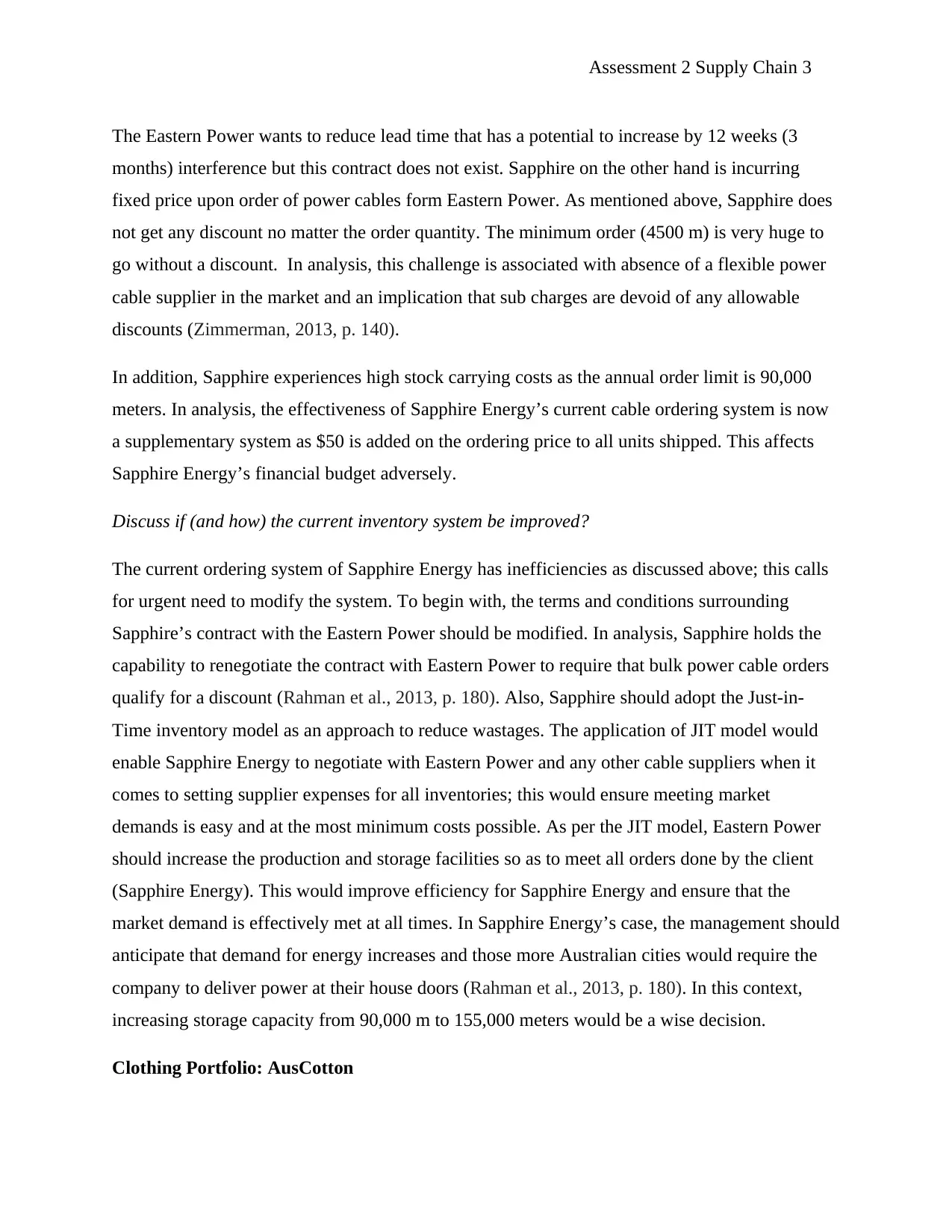
Assessment 2 Supply Chain 3
The Eastern Power wants to reduce lead time that has a potential to increase by 12 weeks (3
months) interference but this contract does not exist. Sapphire on the other hand is incurring
fixed price upon order of power cables form Eastern Power. As mentioned above, Sapphire does
not get any discount no matter the order quantity. The minimum order (4500 m) is very huge to
go without a discount. In analysis, this challenge is associated with absence of a flexible power
cable supplier in the market and an implication that sub charges are devoid of any allowable
discounts (Zimmerman, 2013, p. 140).
In addition, Sapphire experiences high stock carrying costs as the annual order limit is 90,000
meters. In analysis, the effectiveness of Sapphire Energy’s current cable ordering system is now
a supplementary system as $50 is added on the ordering price to all units shipped. This affects
Sapphire Energy’s financial budget adversely.
Discuss if (and how) the current inventory system be improved?
The current ordering system of Sapphire Energy has inefficiencies as discussed above; this calls
for urgent need to modify the system. To begin with, the terms and conditions surrounding
Sapphire’s contract with the Eastern Power should be modified. In analysis, Sapphire holds the
capability to renegotiate the contract with Eastern Power to require that bulk power cable orders
qualify for a discount (Rahman et al., 2013, p. 180). Also, Sapphire should adopt the Just-in-
Time inventory model as an approach to reduce wastages. The application of JIT model would
enable Sapphire Energy to negotiate with Eastern Power and any other cable suppliers when it
comes to setting supplier expenses for all inventories; this would ensure meeting market
demands is easy and at the most minimum costs possible. As per the JIT model, Eastern Power
should increase the production and storage facilities so as to meet all orders done by the client
(Sapphire Energy). This would improve efficiency for Sapphire Energy and ensure that the
market demand is effectively met at all times. In Sapphire Energy’s case, the management should
anticipate that demand for energy increases and those more Australian cities would require the
company to deliver power at their house doors (Rahman et al., 2013, p. 180). In this context,
increasing storage capacity from 90,000 m to 155,000 meters would be a wise decision.
Clothing Portfolio: AusCotton
The Eastern Power wants to reduce lead time that has a potential to increase by 12 weeks (3
months) interference but this contract does not exist. Sapphire on the other hand is incurring
fixed price upon order of power cables form Eastern Power. As mentioned above, Sapphire does
not get any discount no matter the order quantity. The minimum order (4500 m) is very huge to
go without a discount. In analysis, this challenge is associated with absence of a flexible power
cable supplier in the market and an implication that sub charges are devoid of any allowable
discounts (Zimmerman, 2013, p. 140).
In addition, Sapphire experiences high stock carrying costs as the annual order limit is 90,000
meters. In analysis, the effectiveness of Sapphire Energy’s current cable ordering system is now
a supplementary system as $50 is added on the ordering price to all units shipped. This affects
Sapphire Energy’s financial budget adversely.
Discuss if (and how) the current inventory system be improved?
The current ordering system of Sapphire Energy has inefficiencies as discussed above; this calls
for urgent need to modify the system. To begin with, the terms and conditions surrounding
Sapphire’s contract with the Eastern Power should be modified. In analysis, Sapphire holds the
capability to renegotiate the contract with Eastern Power to require that bulk power cable orders
qualify for a discount (Rahman et al., 2013, p. 180). Also, Sapphire should adopt the Just-in-
Time inventory model as an approach to reduce wastages. The application of JIT model would
enable Sapphire Energy to negotiate with Eastern Power and any other cable suppliers when it
comes to setting supplier expenses for all inventories; this would ensure meeting market
demands is easy and at the most minimum costs possible. As per the JIT model, Eastern Power
should increase the production and storage facilities so as to meet all orders done by the client
(Sapphire Energy). This would improve efficiency for Sapphire Energy and ensure that the
market demand is effectively met at all times. In Sapphire Energy’s case, the management should
anticipate that demand for energy increases and those more Australian cities would require the
company to deliver power at their house doors (Rahman et al., 2013, p. 180). In this context,
increasing storage capacity from 90,000 m to 155,000 meters would be a wise decision.
Clothing Portfolio: AusCotton
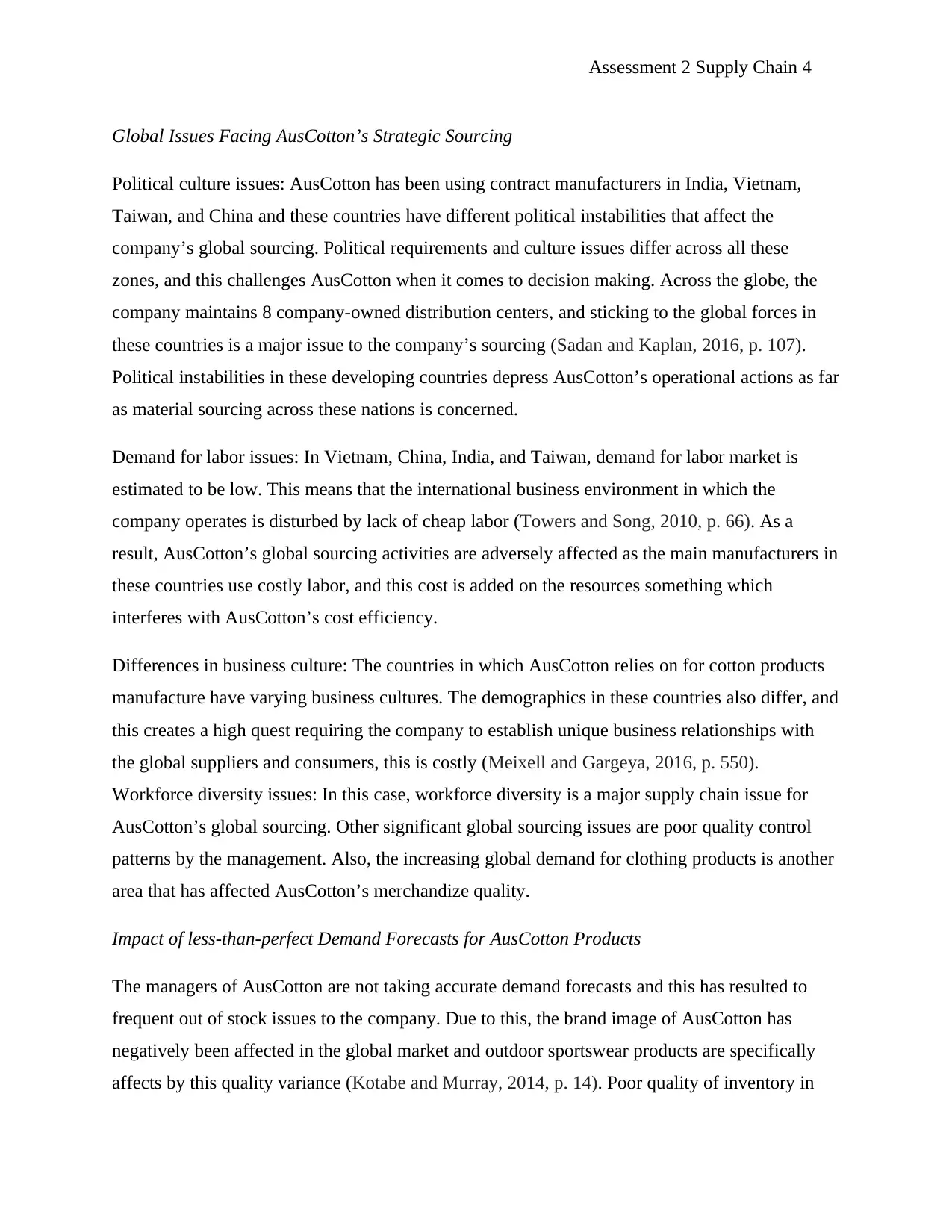
Assessment 2 Supply Chain 4
Global Issues Facing AusCotton’s Strategic Sourcing
Political culture issues: AusCotton has been using contract manufacturers in India, Vietnam,
Taiwan, and China and these countries have different political instabilities that affect the
company’s global sourcing. Political requirements and culture issues differ across all these
zones, and this challenges AusCotton when it comes to decision making. Across the globe, the
company maintains 8 company-owned distribution centers, and sticking to the global forces in
these countries is a major issue to the company’s sourcing (Sadan and Kaplan, 2016, p. 107).
Political instabilities in these developing countries depress AusCotton’s operational actions as far
as material sourcing across these nations is concerned.
Demand for labor issues: In Vietnam, China, India, and Taiwan, demand for labor market is
estimated to be low. This means that the international business environment in which the
company operates is disturbed by lack of cheap labor (Towers and Song, 2010, p. 66). As a
result, AusCotton’s global sourcing activities are adversely affected as the main manufacturers in
these countries use costly labor, and this cost is added on the resources something which
interferes with AusCotton’s cost efficiency.
Differences in business culture: The countries in which AusCotton relies on for cotton products
manufacture have varying business cultures. The demographics in these countries also differ, and
this creates a high quest requiring the company to establish unique business relationships with
the global suppliers and consumers, this is costly (Meixell and Gargeya, 2016, p. 550).
Workforce diversity issues: In this case, workforce diversity is a major supply chain issue for
AusCotton’s global sourcing. Other significant global sourcing issues are poor quality control
patterns by the management. Also, the increasing global demand for clothing products is another
area that has affected AusCotton’s merchandize quality.
Impact of less-than-perfect Demand Forecasts for AusCotton Products
The managers of AusCotton are not taking accurate demand forecasts and this has resulted to
frequent out of stock issues to the company. Due to this, the brand image of AusCotton has
negatively been affected in the global market and outdoor sportswear products are specifically
affects by this quality variance (Kotabe and Murray, 2014, p. 14). Poor quality of inventory in
Global Issues Facing AusCotton’s Strategic Sourcing
Political culture issues: AusCotton has been using contract manufacturers in India, Vietnam,
Taiwan, and China and these countries have different political instabilities that affect the
company’s global sourcing. Political requirements and culture issues differ across all these
zones, and this challenges AusCotton when it comes to decision making. Across the globe, the
company maintains 8 company-owned distribution centers, and sticking to the global forces in
these countries is a major issue to the company’s sourcing (Sadan and Kaplan, 2016, p. 107).
Political instabilities in these developing countries depress AusCotton’s operational actions as far
as material sourcing across these nations is concerned.
Demand for labor issues: In Vietnam, China, India, and Taiwan, demand for labor market is
estimated to be low. This means that the international business environment in which the
company operates is disturbed by lack of cheap labor (Towers and Song, 2010, p. 66). As a
result, AusCotton’s global sourcing activities are adversely affected as the main manufacturers in
these countries use costly labor, and this cost is added on the resources something which
interferes with AusCotton’s cost efficiency.
Differences in business culture: The countries in which AusCotton relies on for cotton products
manufacture have varying business cultures. The demographics in these countries also differ, and
this creates a high quest requiring the company to establish unique business relationships with
the global suppliers and consumers, this is costly (Meixell and Gargeya, 2016, p. 550).
Workforce diversity issues: In this case, workforce diversity is a major supply chain issue for
AusCotton’s global sourcing. Other significant global sourcing issues are poor quality control
patterns by the management. Also, the increasing global demand for clothing products is another
area that has affected AusCotton’s merchandize quality.
Impact of less-than-perfect Demand Forecasts for AusCotton Products
The managers of AusCotton are not taking accurate demand forecasts and this has resulted to
frequent out of stock issues to the company. Due to this, the brand image of AusCotton has
negatively been affected in the global market and outdoor sportswear products are specifically
affects by this quality variance (Kotabe and Murray, 2014, p. 14). Poor quality of inventory in
Secure Best Marks with AI Grader
Need help grading? Try our AI Grader for instant feedback on your assignments.
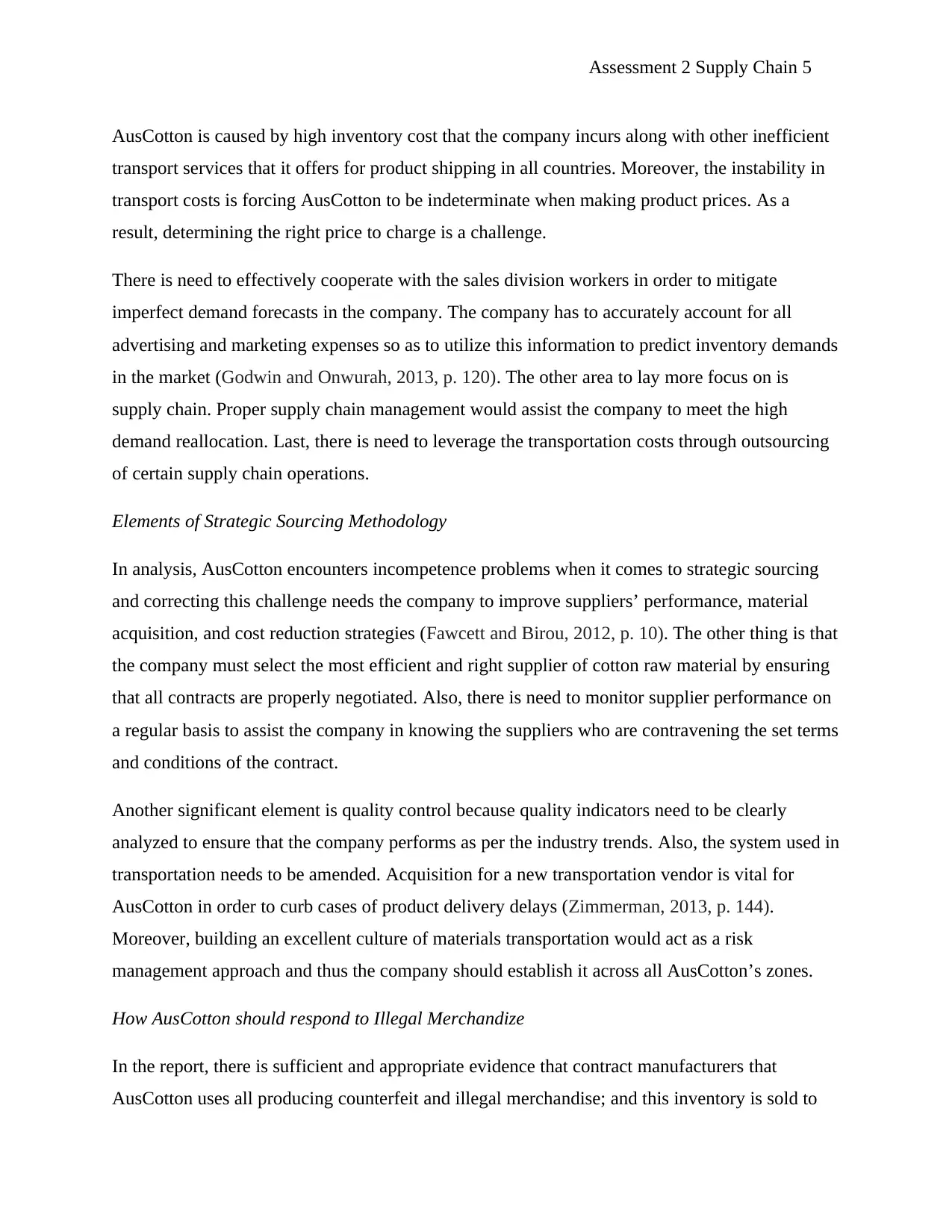
Assessment 2 Supply Chain 5
AusCotton is caused by high inventory cost that the company incurs along with other inefficient
transport services that it offers for product shipping in all countries. Moreover, the instability in
transport costs is forcing AusCotton to be indeterminate when making product prices. As a
result, determining the right price to charge is a challenge.
There is need to effectively cooperate with the sales division workers in order to mitigate
imperfect demand forecasts in the company. The company has to accurately account for all
advertising and marketing expenses so as to utilize this information to predict inventory demands
in the market (Godwin and Onwurah, 2013, p. 120). The other area to lay more focus on is
supply chain. Proper supply chain management would assist the company to meet the high
demand reallocation. Last, there is need to leverage the transportation costs through outsourcing
of certain supply chain operations.
Elements of Strategic Sourcing Methodology
In analysis, AusCotton encounters incompetence problems when it comes to strategic sourcing
and correcting this challenge needs the company to improve suppliers’ performance, material
acquisition, and cost reduction strategies (Fawcett and Birou, 2012, p. 10). The other thing is that
the company must select the most efficient and right supplier of cotton raw material by ensuring
that all contracts are properly negotiated. Also, there is need to monitor supplier performance on
a regular basis to assist the company in knowing the suppliers who are contravening the set terms
and conditions of the contract.
Another significant element is quality control because quality indicators need to be clearly
analyzed to ensure that the company performs as per the industry trends. Also, the system used in
transportation needs to be amended. Acquisition for a new transportation vendor is vital for
AusCotton in order to curb cases of product delivery delays (Zimmerman, 2013, p. 144).
Moreover, building an excellent culture of materials transportation would act as a risk
management approach and thus the company should establish it across all AusCotton’s zones.
How AusCotton should respond to Illegal Merchandize
In the report, there is sufficient and appropriate evidence that contract manufacturers that
AusCotton uses all producing counterfeit and illegal merchandise; and this inventory is sold to
AusCotton is caused by high inventory cost that the company incurs along with other inefficient
transport services that it offers for product shipping in all countries. Moreover, the instability in
transport costs is forcing AusCotton to be indeterminate when making product prices. As a
result, determining the right price to charge is a challenge.
There is need to effectively cooperate with the sales division workers in order to mitigate
imperfect demand forecasts in the company. The company has to accurately account for all
advertising and marketing expenses so as to utilize this information to predict inventory demands
in the market (Godwin and Onwurah, 2013, p. 120). The other area to lay more focus on is
supply chain. Proper supply chain management would assist the company to meet the high
demand reallocation. Last, there is need to leverage the transportation costs through outsourcing
of certain supply chain operations.
Elements of Strategic Sourcing Methodology
In analysis, AusCotton encounters incompetence problems when it comes to strategic sourcing
and correcting this challenge needs the company to improve suppliers’ performance, material
acquisition, and cost reduction strategies (Fawcett and Birou, 2012, p. 10). The other thing is that
the company must select the most efficient and right supplier of cotton raw material by ensuring
that all contracts are properly negotiated. Also, there is need to monitor supplier performance on
a regular basis to assist the company in knowing the suppliers who are contravening the set terms
and conditions of the contract.
Another significant element is quality control because quality indicators need to be clearly
analyzed to ensure that the company performs as per the industry trends. Also, the system used in
transportation needs to be amended. Acquisition for a new transportation vendor is vital for
AusCotton in order to curb cases of product delivery delays (Zimmerman, 2013, p. 144).
Moreover, building an excellent culture of materials transportation would act as a risk
management approach and thus the company should establish it across all AusCotton’s zones.
How AusCotton should respond to Illegal Merchandize
In the report, there is sufficient and appropriate evidence that contract manufacturers that
AusCotton uses all producing counterfeit and illegal merchandise; and this inventory is sold to

Assessment 2 Supply Chain 6
customers via gray market channels. In this case, AusCtton needs to terminate business dealings
with the contract manufacturers who are manufacturing and selling counterfeit goods to the
market (Chaudhrya et al., 2015, p. 70). Illegal merchandizing can greatly tarnish the reputation
of AusCotton in the global market and thus publicly closing association with such manufacturers
would be the best decision. Legally, the presentation of fake merchandize violates IP rights of
AusCotton. Also, involving bureau standards institutions in respective countries to verify
products originality should be implemented with immediate effect. Last, AusCotton needs to take
lawful actions against the contract manufactures for manufacturing fake products under its name.
Conclusion
To conclude, Laburnum Group has faced challenges in the clothing and energy portfolio. The
clothing and energy business portfolios make Laburnum’s largest share in the market. In terms of
stakeholder wealth, company profitability and corporate social roles, the energy and clothing
portfolios form the larger part in decision making. These obstacles include global sourcing
issues, manufacture of counterfeit goods, and unfriendly contractual terms with suppliers, and
lack of discounts for products offered. Therefore, Laburnum should take actions that improve
transportation efficiencies, contractual terms, and global sourcing.
customers via gray market channels. In this case, AusCtton needs to terminate business dealings
with the contract manufacturers who are manufacturing and selling counterfeit goods to the
market (Chaudhrya et al., 2015, p. 70). Illegal merchandizing can greatly tarnish the reputation
of AusCotton in the global market and thus publicly closing association with such manufacturers
would be the best decision. Legally, the presentation of fake merchandize violates IP rights of
AusCotton. Also, involving bureau standards institutions in respective countries to verify
products originality should be implemented with immediate effect. Last, AusCotton needs to take
lawful actions against the contract manufactures for manufacturing fake products under its name.
Conclusion
To conclude, Laburnum Group has faced challenges in the clothing and energy portfolio. The
clothing and energy business portfolios make Laburnum’s largest share in the market. In terms of
stakeholder wealth, company profitability and corporate social roles, the energy and clothing
portfolios form the larger part in decision making. These obstacles include global sourcing
issues, manufacture of counterfeit goods, and unfriendly contractual terms with suppliers, and
lack of discounts for products offered. Therefore, Laburnum should take actions that improve
transportation efficiencies, contractual terms, and global sourcing.
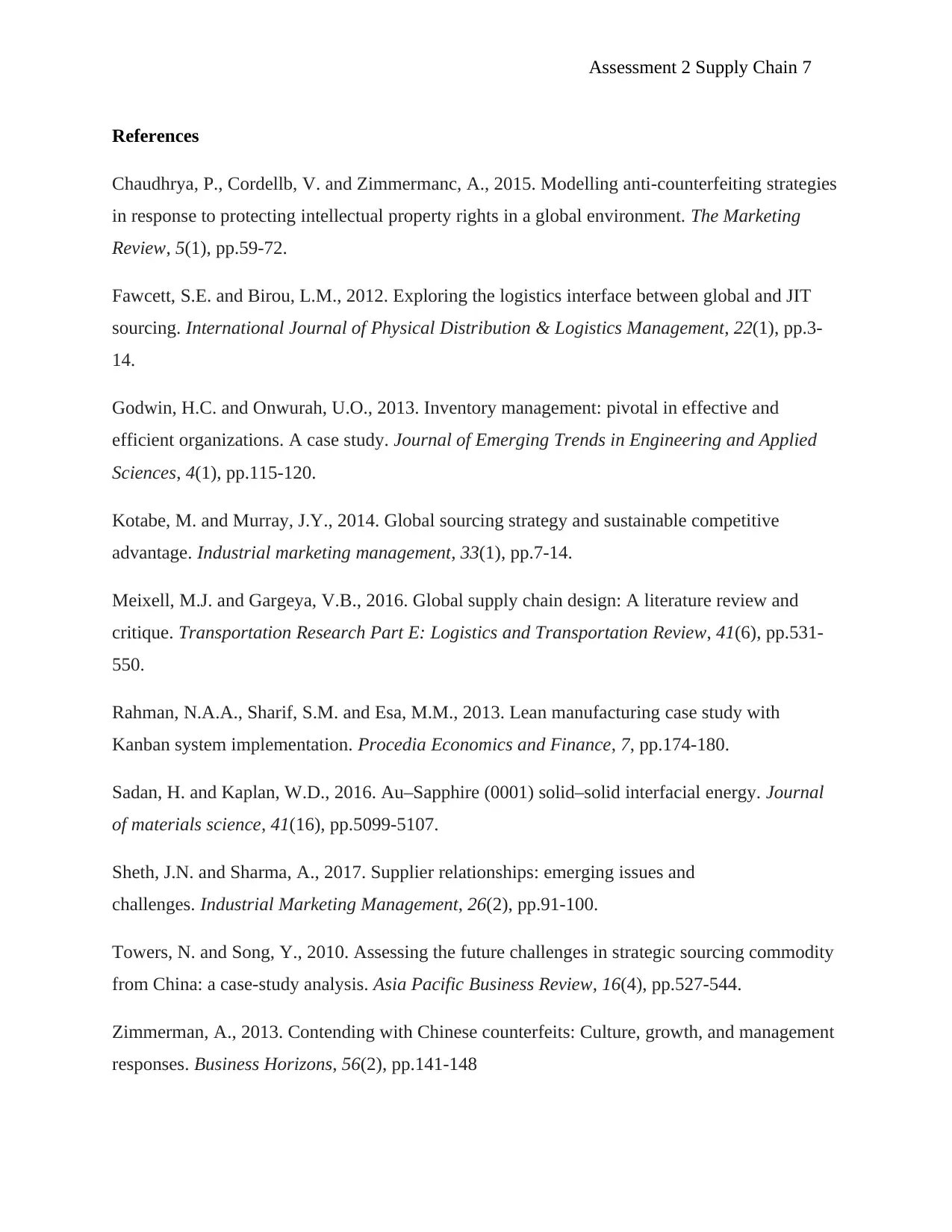
Assessment 2 Supply Chain 7
References
Chaudhrya, P., Cordellb, V. and Zimmermanc, A., 2015. Modelling anti-counterfeiting strategies
in response to protecting intellectual property rights in a global environment. The Marketing
Review, 5(1), pp.59-72.
Fawcett, S.E. and Birou, L.M., 2012. Exploring the logistics interface between global and JIT
sourcing. International Journal of Physical Distribution & Logistics Management, 22(1), pp.3-
14.
Godwin, H.C. and Onwurah, U.O., 2013. Inventory management: pivotal in effective and
efficient organizations. A case study. Journal of Emerging Trends in Engineering and Applied
Sciences, 4(1), pp.115-120.
Kotabe, M. and Murray, J.Y., 2014. Global sourcing strategy and sustainable competitive
advantage. Industrial marketing management, 33(1), pp.7-14.
Meixell, M.J. and Gargeya, V.B., 2016. Global supply chain design: A literature review and
critique. Transportation Research Part E: Logistics and Transportation Review, 41(6), pp.531-
550.
Rahman, N.A.A., Sharif, S.M. and Esa, M.M., 2013. Lean manufacturing case study with
Kanban system implementation. Procedia Economics and Finance, 7, pp.174-180.
Sadan, H. and Kaplan, W.D., 2016. Au–Sapphire (0001) solid–solid interfacial energy. Journal
of materials science, 41(16), pp.5099-5107.
Sheth, J.N. and Sharma, A., 2017. Supplier relationships: emerging issues and
challenges. Industrial Marketing Management, 26(2), pp.91-100.
Towers, N. and Song, Y., 2010. Assessing the future challenges in strategic sourcing commodity
from China: a case-study analysis. Asia Pacific Business Review, 16(4), pp.527-544.
Zimmerman, A., 2013. Contending with Chinese counterfeits: Culture, growth, and management
responses. Business Horizons, 56(2), pp.141-148
References
Chaudhrya, P., Cordellb, V. and Zimmermanc, A., 2015. Modelling anti-counterfeiting strategies
in response to protecting intellectual property rights in a global environment. The Marketing
Review, 5(1), pp.59-72.
Fawcett, S.E. and Birou, L.M., 2012. Exploring the logistics interface between global and JIT
sourcing. International Journal of Physical Distribution & Logistics Management, 22(1), pp.3-
14.
Godwin, H.C. and Onwurah, U.O., 2013. Inventory management: pivotal in effective and
efficient organizations. A case study. Journal of Emerging Trends in Engineering and Applied
Sciences, 4(1), pp.115-120.
Kotabe, M. and Murray, J.Y., 2014. Global sourcing strategy and sustainable competitive
advantage. Industrial marketing management, 33(1), pp.7-14.
Meixell, M.J. and Gargeya, V.B., 2016. Global supply chain design: A literature review and
critique. Transportation Research Part E: Logistics and Transportation Review, 41(6), pp.531-
550.
Rahman, N.A.A., Sharif, S.M. and Esa, M.M., 2013. Lean manufacturing case study with
Kanban system implementation. Procedia Economics and Finance, 7, pp.174-180.
Sadan, H. and Kaplan, W.D., 2016. Au–Sapphire (0001) solid–solid interfacial energy. Journal
of materials science, 41(16), pp.5099-5107.
Sheth, J.N. and Sharma, A., 2017. Supplier relationships: emerging issues and
challenges. Industrial Marketing Management, 26(2), pp.91-100.
Towers, N. and Song, Y., 2010. Assessing the future challenges in strategic sourcing commodity
from China: a case-study analysis. Asia Pacific Business Review, 16(4), pp.527-544.
Zimmerman, A., 2013. Contending with Chinese counterfeits: Culture, growth, and management
responses. Business Horizons, 56(2), pp.141-148
Paraphrase This Document
Need a fresh take? Get an instant paraphrase of this document with our AI Paraphraser

Assessment 2 Supply Chain 8
1 out of 8
Related Documents
Your All-in-One AI-Powered Toolkit for Academic Success.
+13062052269
info@desklib.com
Available 24*7 on WhatsApp / Email
![[object Object]](/_next/static/media/star-bottom.7253800d.svg)
Unlock your academic potential
© 2024 | Zucol Services PVT LTD | All rights reserved.




